Warren J. Gross
Automatic Pruning of Fine-tuning Datasets for Transformer-based Language Models
Jul 11, 2024Abstract:Transformer-based language models have shown state-of-the-art performance on a variety of natural language understanding tasks. To achieve this performance, these models are first pre-trained on general corpus and then fine-tuned on downstream tasks. Previous work studied the effect of pruning the training set of the downstream tasks on the performance of the model on its evaluation set. In this work, we propose an automatic dataset pruning method for the training set of fine-tuning tasks. Our method is based on the model's success rate in correctly classifying each training data point. Unlike previous work which relies on user feedback to determine subset size, our method automatically extracts training subsets that are adapted for each pair of model and fine-tuning task. Our method provides multiple subsets for use in dataset pruning that navigate the trade-off between subset size and evaluation accuracy. Our largest subset, which we also refer to as the winning ticket subset, is on average $3 \times$ smaller than the original training set of the fine-tuning task. Our experiments on 5 downstream tasks and 2 language models show that, on average, fine-tuning on the winning ticket subsets results in a $0.1 \%$ increase in the evaluation performance of the model.
Step-GRAND: A Low Latency Universal Soft-input Decoder
Jul 27, 2023Abstract:GRAND features both soft-input and hard-input variants that are well suited to efficient hardware implementations that can be characterized with achievable average and worst-case decoding latency. This paper introduces step-GRAND, a soft-input variant of GRAND that, in addition to achieving appealing average decoding latency, also reduces the worst-case decoding latency of the corresponding hardware implementation. The hardware implementation results demonstrate that the proposed step-GRAND can decode CA-polar code $(128,105+11)$ with an average information throughput of $47.7$ Gbps at the target FER of $\leq10^{-7}$. Furthermore, the proposed step-GRAND hardware is $10\times$ more area efficient than the previous soft-input ORBGRAND hardware implementation, and its worst-case latency is $\frac{1}{6.8}\times$ that of the previous ORBGRAND hardware.
SSS3D: Fast Neural Architecture Search For Efficient Three-Dimensional Semantic Segmentation
Apr 21, 2023



Abstract:We present SSS3D, a fast multi-objective NAS framework designed to find computationally efficient 3D semantic scene segmentation networks. It uses RandLA-Net, an off-the-shelf point-based network, as a super-network to enable weight sharing and reduce search time by 99.67% for single-stage searches. SSS3D has a complex search space composed of sampling and architectural parameters that can form 2.88 * 10^17 possible networks. To further reduce search time, SSS3D splits the complete search space and introduces a two-stage search that finds optimal subnetworks in 54% of the time required by single-stage searches.
FMAS: Fast Multi-Objective SuperNet Architecture Search for Semantic Segmentation
Mar 28, 2023Abstract:We present FMAS, a fast multi-objective neural architecture search framework for semantic segmentation. FMAS subsamples the structure and pre-trained parameters of DeepLabV3+, without fine-tuning, dramatically reducing training time during search. To further reduce candidate evaluation time, we use a subset of the validation dataset during the search. Only the final, Pareto non-dominated, candidates are ultimately fine-tuned using the complete training set. We evaluate FMAS by searching for models that effectively trade accuracy and computational cost on the PASCAL VOC 2012 dataset. FMAS finds competitive designs quickly, e.g., taking just 0.5 GPU days to discover a DeepLabV3+ variant that reduces FLOPs and parameters by 10$\%$ and 20$\%$ respectively, for less than 3$\%$ increased error. We also search on an edge device called GAP8 and use its latency as the metric. FMAS is capable of finding 2.2$\times$ faster network with 7.61$\%$ MIoU loss.
BD-KD: Balancing the Divergences for Online Knowledge Distillation
Dec 25, 2022Abstract:Knowledge distillation (KD) has gained a lot of attention in the field of model compression for edge devices thanks to its effectiveness in compressing large powerful networks into smaller lower-capacity models. Online distillation, in which both the teacher and the student are learning collaboratively, has also gained much interest due to its ability to improve on the performance of the networks involved. The Kullback-Leibler (KL) divergence ensures the proper knowledge transfer between the teacher and student. However, most online KD techniques present some bottlenecks under the network capacity gap. By cooperatively and simultaneously training, the models the KL distance becomes incapable of properly minimizing the teacher's and student's distributions. Alongside accuracy, critical edge device applications are in need of well-calibrated compact networks. Confidence calibration provides a sensible way of getting trustworthy predictions. We propose BD-KD: Balancing of Divergences for online Knowledge Distillation. We show that adaptively balancing between the reverse and forward divergences shifts the focus of the training strategy to the compact student network without limiting the teacher network's learning process. We demonstrate that, by performing this balancing design at the level of the student distillation loss, we improve upon both performance accuracy and calibration of the compact student network. We conducted extensive experiments using a variety of network architectures and show improvements on multiple datasets including CIFAR-10, CIFAR-100, Tiny-ImageNet, and ImageNet. We illustrate the effectiveness of our approach through comprehensive comparisons and ablations with current state-of-the-art online and offline KD techniques.
Efficient Fine-Tuning of Compressed Language Models with Learners
Aug 03, 2022



Abstract:Fine-tuning BERT-based models is resource-intensive in memory, computation, and time. While many prior works aim to improve inference efficiency via compression techniques, e.g., pruning, these works do not explicitly address the computational challenges of training to downstream tasks. We introduce Learner modules and priming, novel methods for fine-tuning that exploit the overparameterization of pre-trained language models to gain benefits in convergence speed and resource utilization. Learner modules navigate the double bind of 1) training efficiently by fine-tuning a subset of parameters, and 2) training effectively by ensuring quick convergence and high metric scores. Our results on DistilBERT demonstrate that learners perform on par with or surpass the baselines. Learners train 7x fewer parameters than state-of-the-art methods on GLUE. On CoLA, learners fine-tune 20% faster, and have significantly lower resource utilization.
Efficient Fine-Tuning of BERT Models on the Edge
May 03, 2022



Abstract:Resource-constrained devices are increasingly the deployment targets of machine learning applications. Static models, however, do not always suffice for dynamic environments. On-device training of models allows for quick adaptability to new scenarios. With the increasing size of deep neural networks, as noted with the likes of BERT and other natural language processing models, comes increased resource requirements, namely memory, computation, energy, and time. Furthermore, training is far more resource intensive than inference. Resource-constrained on-device learning is thus doubly difficult, especially with large BERT-like models. By reducing the memory usage of fine-tuning, pre-trained BERT models can become efficient enough to fine-tune on resource-constrained devices. We propose Freeze And Reconfigure (FAR), a memory-efficient training regime for BERT-like models that reduces the memory usage of activation maps during fine-tuning by avoiding unnecessary parameter updates. FAR reduces fine-tuning time on the DistilBERT model and CoLA dataset by 30%, and time spent on memory operations by 47%. More broadly, reductions in metric performance on the GLUE and SQuAD datasets are around 1% on average.
Standard Deviation-Based Quantization for Deep Neural Networks
Feb 24, 2022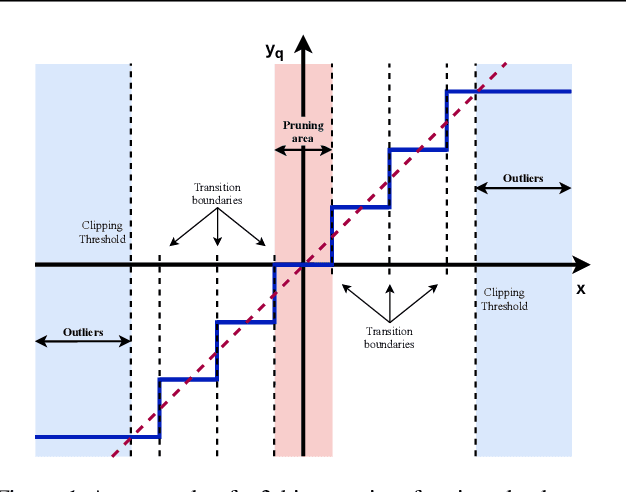
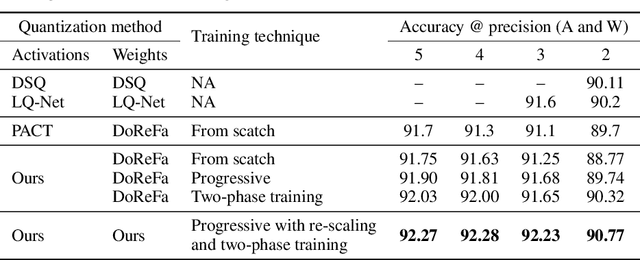
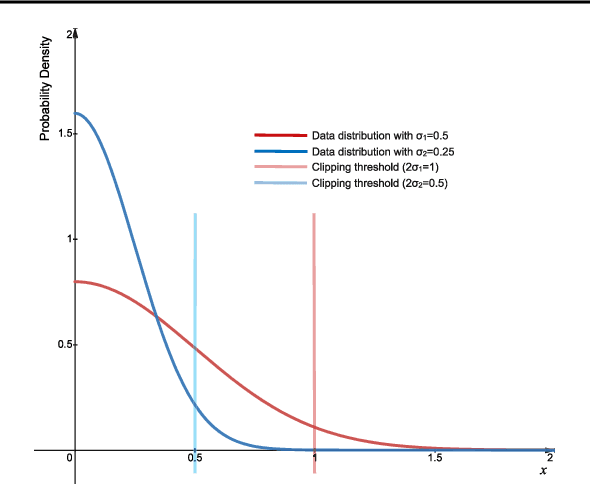
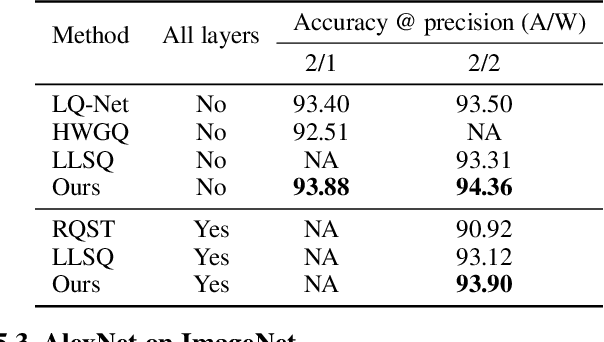
Abstract:Quantization of deep neural networks is a promising approach that reduces the inference cost, making it feasible to run deep networks on resource-restricted devices. Inspired by existing methods, we propose a new framework to learn the quantization intervals (discrete values) using the knowledge of the network's weight and activation distributions, i.e., standard deviation. Furthermore, we propose a novel base-2 logarithmic quantization scheme to quantize weights to power-of-two discrete values. Our proposed scheme allows us to replace resource-hungry high-precision multipliers with simple shift-add operations. According to our evaluations, our method outperforms existing work on CIFAR10 and ImageNet datasets and even achieves better accuracy performance with 3-bit weights and activations when compared to the full-precision models. Moreover, our scheme simultaneously prunes the network's parameters and allows us to flexibly adjust the pruning ratio during the quantization process.
Fast Successive-Cancellation List Flip Decoding of Polar Codes
Sep 25, 2021



Abstract:This work presents a fast successive-cancellation list flip (Fast-SCLF) decoding algorithm for polar codes that addresses the high latency issue associated with the successive-cancellation list flip (SCLF) decoding algorithm. We first propose a bit-flipping strategy tailored to the state-of-the-art fast successive-cancellation list (FSCL) decoding that avoids tree-traversal in the binary tree representation of SCLF, thus reducing the latency of the decoding process. We then derive a parameterized path-selection error model to accurately estimate the bit index at which the correct decoding path is eliminated from the initial FSCL decoding. The trainable parameter is optimized online based on an efficient supervised learning framework. Simulation results show that for a polar code of length 512 with 256 information bits, with similar error-correction performance and memory consumption, the proposed Fast-SCLF decoder reduces up to $73.4\%$ of the average decoding latency of the SCLF decoder with the same list size at the frame error rate of $10^{-4}$, while incurring a maximum computational overhead of $36.2\%$. For the same polar code of length 512 with 256 information bits and at practical signal-to-noise ratios, the proposed decoder with list size 4 reduces $89.1\%$ and $43.7\%$ of the average complexity and decoding latency of the FSCL decoder with list size 32 (FSCL-32), respectively, while also reducing $83.3\%$ of the memory consumption of FSCL-32. The significant improvements of the proposed decoder come at the cost of only $0.07$ dB error-correction performance degradation compared with FSCL-32.
Learning to Skip Ineffectual Recurrent Computations in LSTMs
Nov 29, 2018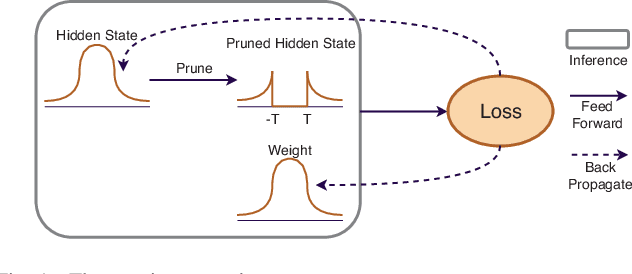
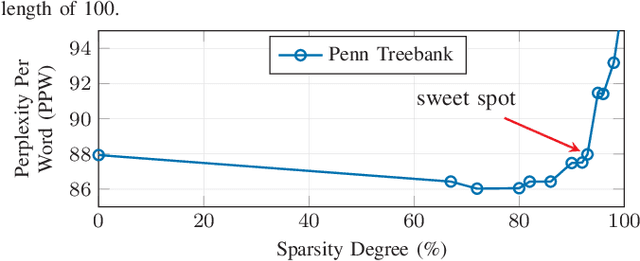
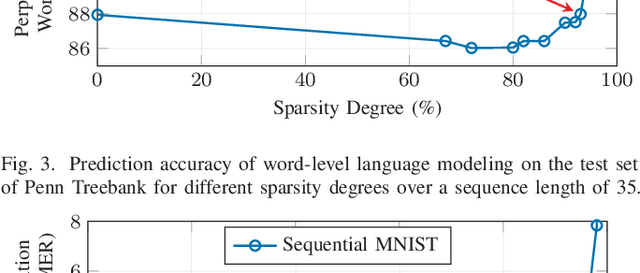

Abstract:Long Short-Term Memory (LSTM) is a special class of recurrent neural network, which has shown remarkable successes in processing sequential data. The typical architecture of an LSTM involves a set of states and gates: the states retain information over arbitrary time intervals and the gates regulate the flow of information. Due to the recursive nature of LSTMs, they are computationally intensive to deploy on edge devices with limited hardware resources. To reduce the computational complexity of LSTMs, we first introduce a method that learns to retain only the important information in the states by pruning redundant information. We then show that our method can prune over 90% of information in the states without incurring any accuracy degradation over a set of temporal tasks. This observation suggests that a large fraction of the recurrent computations are ineffectual and can be avoided to speed up the process during the inference as they involve noncontributory multiplications/accumulations with zero-valued states. Finally, we introduce a custom hardware accelerator that can perform the recurrent computations using both sparse and dense states. Experimental measurements show that performing the computations using the sparse states speeds up the process and improves energy efficiency by up to 5.2x when compared to implementation results of the accelerator performing the computations using dense states.
 Add to Chrome
Add to Chrome Add to Firefox
Add to Firefox Add to Edge
Add to Edge